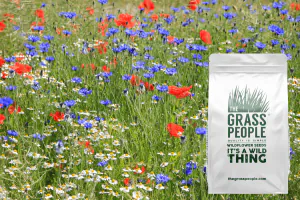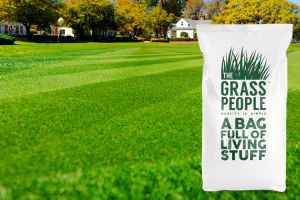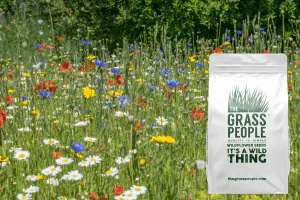SIMPLY: Wildflowers
- A beginner’s wildflower mix
- Helps to create a habitat for pollinators and other wildlife
- Provides a variety of flora for novice’s to find their favourites

You may also like...

- A vibrant mix of pollinator-perfect flora
- Contains a balanced mix of annuals, perennials and grasses
- Wildflowers expertly picked for their bee attracting abilities

- Fast-growing and quick to establish
- Wear-and-tear tolerant
- Creates a lusciously green lawn
Please refresh the page in 1 minute to see the next delivery time.
How much do I need?
Simply enter the length and width of the area, to calculate how much you need.
Product Description
Our SIMPLY: Wildflowers mix is the economical answer for wildflower novices venturing into making their first meadow. Made up of annual and perennial wildflowers, and appropriate grass species to give you the basic basis of a wildflower meadow. New to wildflowers? You’ll enjoy the benefits of this low-maintenance mix at an economical price. The grasses in this mix provide a nursery for the wildflowers, meaning your wildflower garden stays weed free and wildflower full. SIMPLY: Wildflowers can spruce up your small and large spaces easily and provide a food source for bees and pollinators, as it contains RHS Plants for Pollinators wildflowers.
Mixture Breakdown

June - September
What colour is it?White
Annual or Perennial?Perennial
Latin NameTrifolium repens
DescriptionWhite Clover is a great source of food for bees and pollinators who can enjoy its nectar from a slightly shorter height. Its dome flowers create a pretty globe of white blooms.

May – September
What colour is it?Purple
Annual or Perennial?Annual
Latin NameAgrostemma githago
DescriptionCorncockle is a pretty purple wildflower with tall stems and full petals and is a bright addition to any annuals mix. It is currently rare and endangered.

June – August
What colour is it?Red / Black
Annual or Perennial?Annual
Latin NamePapaver rhoeas
DescriptionCorn Poppy is a vibrant and bright addition to any meadow and easily recognisable and identifiable throughout the UK. Of course it has meaning for many, and also adds a colourful pop to any wildflower plot!

March – November
What colour is it?Pink
Annual or Perennial?Perennial
Latin NameSilene dioica
DescriptionRed Campion has hot pink petals that make for quite the show stopper in your wildflower meadow, and can typically be found in woodland areas. Red Campion begins to flower once bluebells begin to fade, so if you notice this happening in your wildflower sward you can begin to look forward to their fuchsia blooms!

June - October
What colour is it?Yellow
Annual or Perennial?Annual
Latin NameGlebionis segetum
DescriptionCorn Marigold is a bright ray of sunshine on a gloomy day. Its orange-yellow petals burst into life in June and last all the way through until October. Part of the cornfield annuals family, although this annual may have one showing - it’s a showstopper!

June – August
What colour is it?Violet
Annual or Perennial?Annual
Latin NameCentaurea cyanus
DescriptionCornflower was previously considered a weed in amongst its cornfield annuals companions but is now accepted and widely praised as one of its finest! We're not surprised - who could dismiss those electric blue blooms?

May – September
What colour is it?White / Yellow
Annual or Perennial?Perennial
Latin NameLeucanthemum vulgare
DescriptionImagine the daisy chain these would make! Oxeye Daisy is the largest member of the daisy family and its almost flat surface makes the perfect landing pad for bees and pollinators.

January – December
What colour is it?White / Brown
Annual or Perennial?Perennial
Latin NamePlantago lanceolata
DescriptionRibwort Plantain although not the brightest wildflower, certainly adds a natural diversity to your wildflower meadow. Its tiny white buds provide food for bees and pollinators whilst its seeds are great for Goldfinches.

May – September
What colour is it?Pink / Green
Annual or Perennial?Perennial
Latin NameSanguisorba minor
DescriptionA perennial wildflower with toothed leaves and pink flowers, its leaves when crushed smell like cucumber and used to be used in salads!

May – September
What colour is it?Yellow / Red
Annual or Perennial?Perennial
Latin NameLotus corniculatus
DescriptionBirdsfoot Trefoil is part of the pea family and grows up to 35cm. It is well known for its yellow slipper like petals and red centre, which has given it the nickname of 'Eggs and Bacon'!

May - September
What colour is it?Yellow
Annual or Perennial?Annual
Latin NameRhinanthus minor
DescriptionYellow Rattle can be used in existing meadows where meadow grasses have taken over. It helps to weaken these grasses to allow other wildflowers to flourish, and does this by locking its roots to those of the grasses, and therefore lessens their abundance.

June – November
What colour is it?White / Occasionally pink
Annual or Perennial?Perennial
Latin NameAchillea millefolium
DescriptionYarrow produces clusters of white small-petalled blooms. It is an aromatic perennial making it particularly attractive to bees and pollinators who are enamoured by its sweet scent.

May - September
What colour is it?Purple
Annual or Perennial?Perennial
Latin NameVicia sativa ssp. Segetalis
DescriptionCommon Vetch produces delicate purple flowers that make it a very desirable wildflower. It is considered a 'scrambling plant', which means it makes an extra special effort to climb to the sun and weave its way above many other wildflowers.

June - September
What colour is it?White / Yellow
Annual or Perennial?Annual
Latin NameAnthemis arvensis
DescriptionAlthough Corn Chamomile looks like a daisy, it is part of the cornfield annuals family. With its flat and almost-level surface it makes the perfect pit-stop for bees and pollinators.

May – September
What colour is it?Purple / Pink
Annual or Perennial?Perennial
Latin NameTrifolium pratense
DescriptionRed Clover is a popular perennial that despite its name, is actually purple! It's dome-shaped flowers are relatively low-growing which makes it the perfect fodder food for livestock but is also a fan favourite of weary bees who need a feed a little closer to the ground.

This is a grass seed and typically germinates at temperatures of 8 -10 degrees
What colour is it?Green / Beige
Annual or Perennial?Perennial
Latin NameFestuca rubra
DescriptionStrong Creeping Red Fescue is a grass that performs in most soil types

This is a grass seed and typically germinates at temperatures of 8 -10 degrees
What colour is it?Green / Beige
Annual or Perennial?Perennial
Latin NameFestuca rubra ssp. Commutata
DescriptionChewing's Fescue is a grass that performs in most soil types

This is a grass seed and typically germinates at temperatures of 8 -10 degrees
What colour is it?Green / Beige
Annual or Perennial?Perennial
Latin NameFestuca rubra
DescriptionStrong Creeping Red Fescue is a grass that performs in most soil types

This is a grass seed and typically germinates at temperatures of 8 -10 degrees
What colour is it?Green / Beige
Annual or Perennial?Perennial
Latin NamePoa pratensis
DescriptionSmooth Stalked Meadow Grass is a grass that performs in most soil types

This is a grass seed and typically germinates at temperatures of 8 -10 degrees
What colour is it?Green / Beige
Annual or Perennial?Perennial
Latin NameAgrostis vinealis
DescriptionBrowntop Bentgrass is a grass that performs in most soil types
Usage Guide
● Remove any existing grass, plants or flora from the area where you plan to sow your wildflower seed. Failure to do this will produce poor results
● Further remove the top 5-10cm to reduce soil fertility
● Allow the area to cultivate for several weeks, and remove any weeds that may pop in the area during this time
● Do not be tempted to add top soil, compost or fertiliser to the area - wildflowers prefer low nutrient conditions
● After the cultivation period ensure to remove stones or any other debris and rake the area to create a fine, friable and level seedbed
● Scatter the seed at a rate of 5g per m2
● Rake the seed so that it is in amongst the soil
● Water the just-sown wildflower seed well
● If sowing in drought conditions, water as required to keep the area moist in the first 6 weeks after sowing
Read our full guide on how to manage your wildflower meadow here.
| Sowing Rate | 5g per m2 |
| When | For best results sow in March/April or in September |
Aftercare
End of year cut:
- We recommend doing this essential end-of-year cut in autumn.
- Your wildflowers are ready for their first cut when they have grown to 7cm and have gone to seedhead.
- This cut can be done using your lawn mower at its highest setting or using a strimmer.
Early spring cut:
- An early spring cut is ideal when your wildflowers are well-established.
- This early spring cut trims back meadow grasses and helps increase the density of the wildflowers.
- This cut also encourages wildflowers to grow better later that season.
- Cut before the end of April, or you may stunt their growth, and they could skip blooming that year.
Summer cut (optional):
- A cut between June and August can encourage the growth of wildflowers later in the season.
- Cut back to 7cm tall and remove the cuttings.
- This optional cut encourages new wildflowers to grow and flourish.
What to do with the cuttings (if you have annual wildflowers in the mix):
In dry conditions:
- If conditions will be dry for 5-7 days, you can let the cuttings lie on the ground so the seeds drop.
- Walk over, use a roller or shake the seedheads to encourage the seeds to fall and grow next season.
- Then remove the plant cuttings after a week and dispose of them in your garden waste bin.
In wet conditions:
- Lift the clippings if rainfall is forecast, and manually free up the seeds by crushing the seedhead to collect the seeds for replanting.
- When dry conditions return, scatter the seeds across your wildflower area.
- Alternatively, you can store your collected wildflower seeds in an envelope and replant them later.
For further reading, check out our guide on when and how often to cut a wildflower meadow.
The above photo depicts the variety of species you should expect to see in your wildflower display. Please note that certain species within this mix and all our wildflower mixes may become more abundant than others, and this varies based on the conditions in which they are sown. Taking this into consideration, your wildflower meadow will evolve and adapt year after year and change in appearance as certain species may become more dominant than others.







